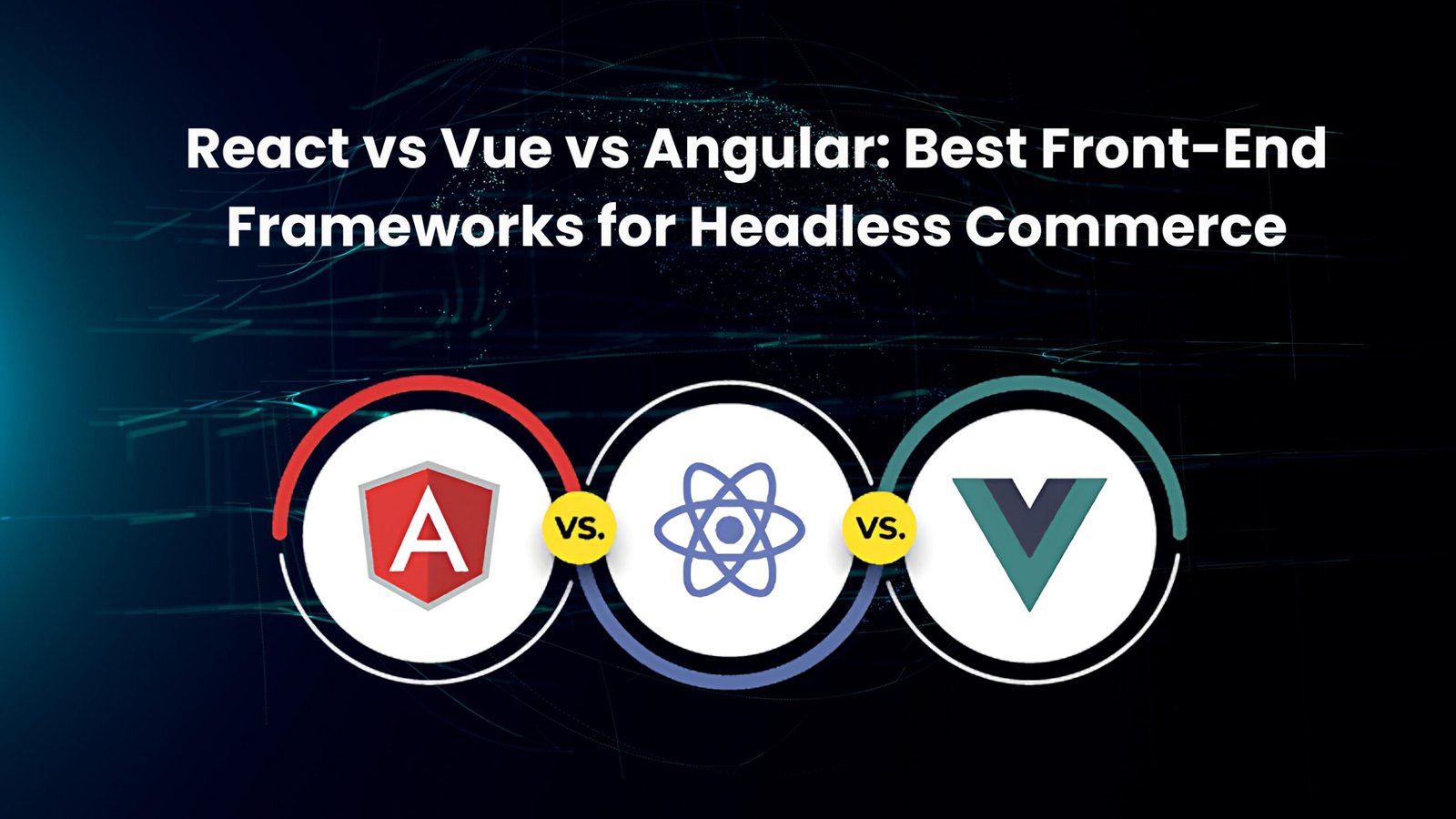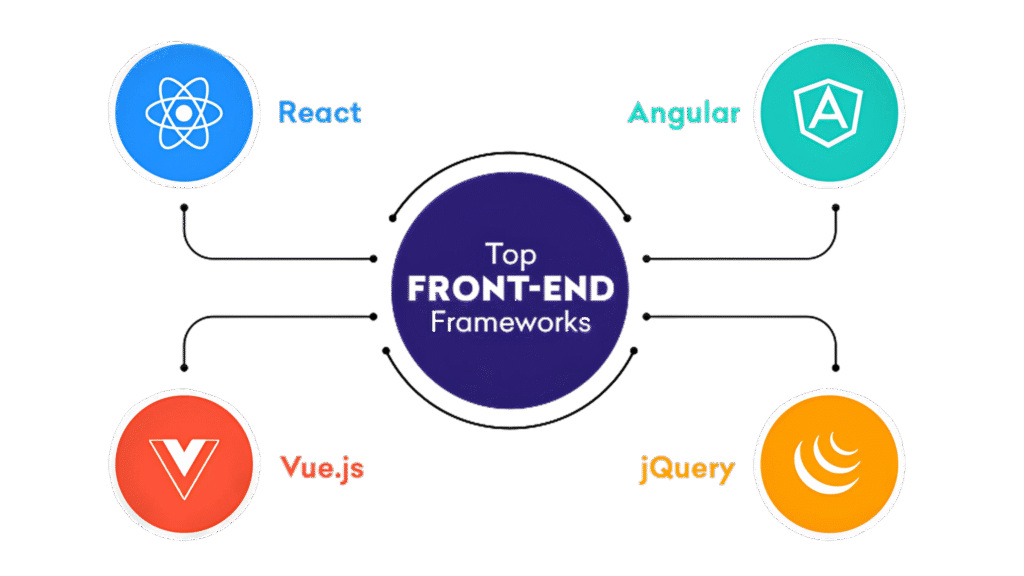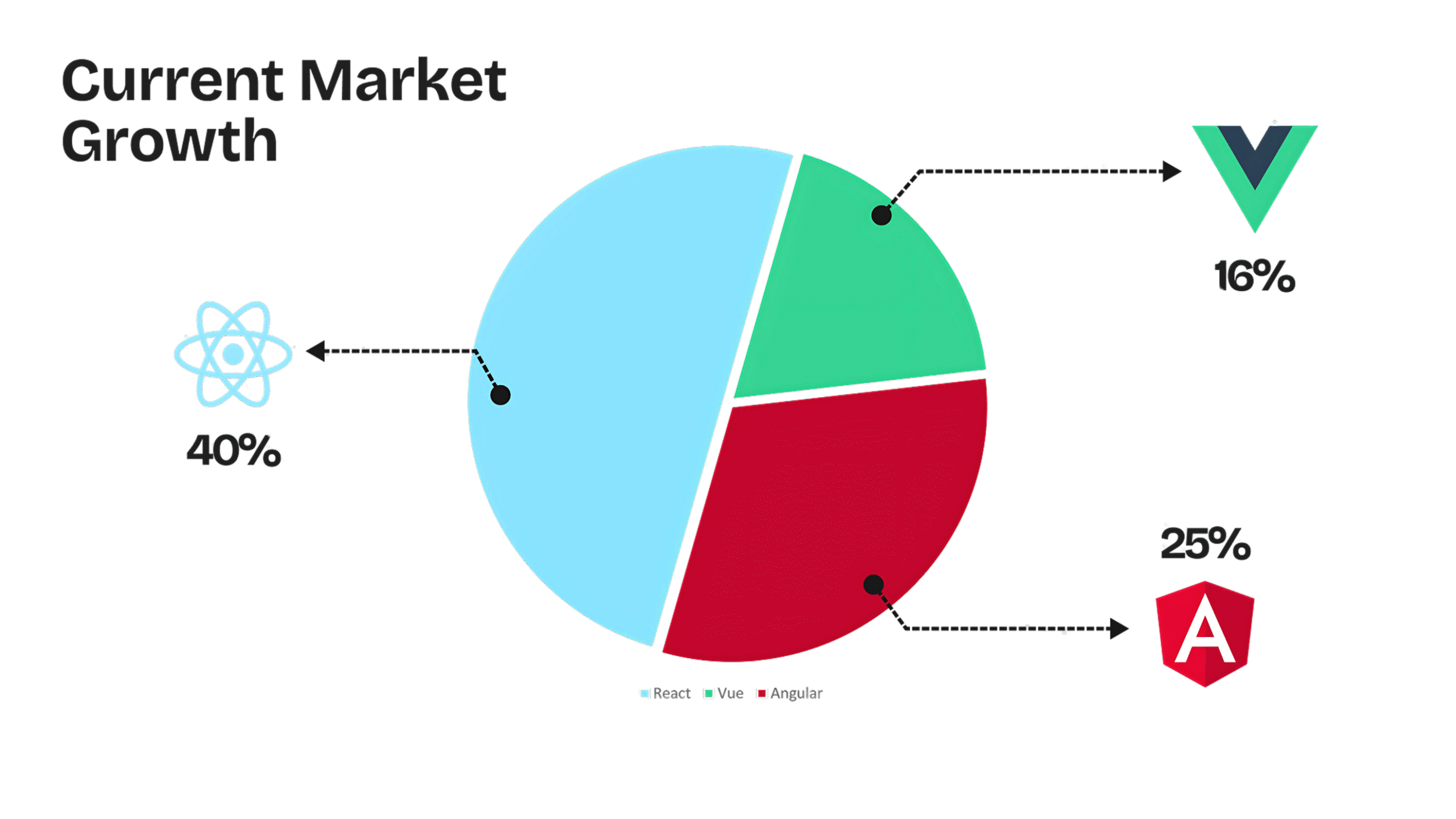Why a Proactive Cybersecurity Strategy Is Crucial for eCommerce Success


The choice of a front-end framework has become one of the most important decisions in modern web development. It affects how fast applications load, how easily they scale, how well they perform in search rankings, and how productive teams can be when building features. For companies investing in headless commerce and digital platforms, the framework decision directly impacts business results.
Over the years, JavaScript front-end framework have reshaped the way applications are built. What started with jQuery’s quick fixes moved into more structured approaches with Angular, then into the component-driven flexibility of React and Vue. Today, the landscape includes not only these core frameworks but also meta-frameworks like Next.js, Nuxt, and SvelteKit that add layers of optimization and server-side rendering.
React, Vue, and Angular remain the most widely adopted choices, each backed by strong communities and ecosystems. The challenge for businesses is not deciding which front-end framework is most popular, but which one best supports their goals in performance optimization, scalability, and integration with headless commerce solutions.
This blog explores the strengths and trade-offs of each front-end framework, compares their performance in enterprise contexts, and highlights real-world case studies to show what the right choice can deliver in practice. But first, let’s understand why this decision matters so much for enterprise success.
For enterprises, picking a front-end framework is more than a technical decision. It directly influences how digital platforms perform, scale, and support growth. The framework you choose becomes the foundation for customer experiences, and it can either accelerate or slow down digital transformation.
Framework choice shapes scalability, performance, costs, and the speed at which new ideas reach customers. For enterprises balancing digital transformation goals, this decision is a strategic lever, not a side note.
Before comparing frameworks, it’s important to clarify what they actually are and how they’ve evolved. This context helps decision-makers understand not only the technical landscape but also why these tools matter for long-term business outcomes.
A front-end framework is a structured set of tools, rules, and components that developers use to build user interfaces and manage application logic. It provides opinionated patterns for how code should be organized, tested, and deployed. In contrast, a library like React on its own offers reusable pieces of code but leaves many architectural decisions to the development team. This difference matters for enterprises: frameworks create consistency across teams, while libraries offer flexibility at the cost of governance.
The story of front-end framework development shows why frameworks are so critical today:

The evolution shows a clear pattern:
Below, we compare React, Vue, and Angular in the context of headless commerce. We highlight strengths, trade-offs, and real outcomes from companies that have implemented them. This comparison helps show what each framework delivers in practice for businesses concerned about performance, scalability, and SEO.

Strengths
Weaknesses
Real-World Case Study: Saranoni using Shopify Hydrogen
Real-World Case: Half Helix / Shopify Supply
Strengths
Weaknesses
Real-World Case: Alibaba’s SSR / Vue Usage
Additional Vue Example.
Trivago using Vue to improve real-time filters and search experience; users see faster responses when browsing and filtering; better UI interactivity.
Strengths
Weaknesses
Real-World Case Study: This Dot Labs with Angular
Below is a summary comparing the three frameworks in headless commerce contexts, based on real business outcomes and trade-offs:
| Dimension | React (with Hydrogen / Next.js) | Vue (with Nuxt) | Angular |
| Initial Load Time & SEO | Very strong when SSR / Hydrogen used; e.g., Saranoni: 1-2s load time; Allbirds etc saw big CWV improvements. | Strong for interactive and content heavy sites; Alibaba’s SSR improved visible load and CTR. | Good after optimizations; but initial load can be slower; needs careful bundling and lazy loading, as in financial client case. |
| Flexibility & Ecosystem | Very large; many plugins, headless commerce integrations; Hydrogen, Next.js etc. | Good ecosystem, especially for content-heavy sites, Vue Storefront etc. | More opinionated; fewer headless commerce examples but strong in enterprise internal tools and regulated environments. |
| Developer Onboarding / Productivity | Higher cost to start (learning React + headless + SSR) but high payoff; teams get faster iteration after initial setup. | Lower entry barrier; quicker productivity for small to medium teams. | Steep learning; requires discipline, but once patterns are established, maintenance tends to be stable. |
| Scalability & Maintenance | Scales well especially with componentization, micro frontends, edge deployment. | Scales well for content platforms, marketplaces; works well if modules are kept clean. | High scalability for large enterprise systems with many modules; TypeScript and strong patterns help avoid drift. |
These real examples show that there is no “one size fits all.” React with Hydrogen shines for headless commerce and performance optimization; Vue is strong for sites needing fast interactivity and good content handling; Angular remains a solid choice when enterprise structure, maintainability, and long-term support are critical.
Performance optimization is one of the most critical factors in framework choice. For enterprises, it is not just a technical metric but a driver of business outcomes: faster sites rank higher on search engines, convert better, and reduce infrastructure costs. Each of the three leading frameworks – React, Vue, and Angular – has a different profile when it comes to optimization.
React on its own is client-side focused, which can hurt SEO and initial load performance. Paired with Next.js or Hydrogen, it becomes a strong performer. Companies like Saranoni cut page load times from 5–20 seconds to 1–2 seconds using Hydrogen, resulting in higher conversion rates. Another example is Allbirds, which migrated to a headless React and Next.js architecture and saw measurable improvements in Core Web Vitals, boosting both SEO rankings and customer engagement.
Vue shines when paired with Nuxt.js. Server-side rendering comes built-in, making performance optimization easier. Alibaba, during its Singles Day festival, implemented Vue with SSR and saw a one-second visible rendering rate for over 80% of users, including those on low-end Android devices. That translated into better user engagement and higher click-through rates, proving that Vue with Nuxt can deliver results at global scale.
Angular includes many tools out of the box, but this can lead to heavier bundles. Without optimization, applications may suffer from slower initial loads. However, enterprises that tune Angular see strong results. In one financial services case, performance analysis identified heavy JavaScript and inefficient rendering as bottlenecks. After implementing lazy loading, code splitting, and image optimizations, the platform improved Core Web Vitals scores, which directly improved SEO visibility and reduced bounce rates.
For enterprises running headless commerce or global applications, performance optimization is not optional. Frameworks that support SSR, efficient bundling, and edge delivery like React with Next.js or Vue with Nuxt – tend to lead the pack. Angular, while heavier, remains viable when paired with disciplined performance tuning and is often favored for stability in enterprise-scale environments.
Performance and scalability may drive the headlines, but developer experience often determines whether a project succeeds in the long run. A framework that feels intuitive, has strong tooling, and connects easily with the platforms an enterprise depends on will save months of effort and reduce frustration for teams.
React has become the most widely adopted option, which means most developers are familiar with it. That reduces hiring risk and shortens onboarding. At the same time, React requires choices about state management, routing, and other essentials, which can slow teams down if not guided by experienced architects.
Vue is often praised for its gentle learning curve. Many teams find they can get productive in days rather than weeks, which is valuable for companies with smaller engineering groups or faster product cycles.
Angular has the steepest learning curve of the three. It is highly structured and TypeScript-driven, which means new developers may take longer to ramp up. The payoff is consistency across teams, which can be crucial in large enterprises managing many applications.
We recently worked with an enterprise SaaS company serving Fortune 500 clients in healthcare and finance. As they scaled from 50 to 500 employees, they needed to rebuild their platform architecture. The leadership team faced a common dilemma: React offered faster development cycles and easier talent acquisition, but Angular provided the structure and governance their regulated environment demanded.
In our consulting experience, this decision often comes down to three factors:
The right choice isn’t about which framework is “better”—it’s about which one accelerates your specific business goals while managing risk. RBM helps enterprises weigh these trade-offs by connecting technical capabilities to measurable outcomes like time-to-market, compliance costs, and developer productivity.
Framework choice also affects how easily you can integrate with headless CMS, commerce engines, or enterprise APIs. React dominates in this area. Tools like Next.js, Hydrogen, and Gatsby make React the default for many headless commerce projects, with plug-and-play integrations for Shopify, Contentful, and CommerceTools.
Vue is growing its enterprise ecosystem, with Nuxt powering SEO-friendly sites and Vue Storefront supporting commerce integrations. It is strong for content-heavy and marketplace applications.
Angular, while less common in headless commerce, remains a mainstay in financial services, telecom, and government, where robust structure and long-term maintainability outweigh ecosystem flexibility.
A framework with a big, active community makes hiring easier and reduces project risk. React has the largest developer pool and shows up in job listings across regions. The State of JavaScript 2024 survey confirms this trend, with React maintaining its dominant position while Vue holds steady as the second most popular choice among 40,000+ developers worldwide. That means shorter time to hire and more contractors available when you need burst capacity.
Vue has strong pockets of adoption, especially in parts of Europe and Asia, which can be an advantage if your business operates there. Angular remains common in large enterprises and government projects, so if you need experienced engineers who know strict patterns and TypeScript you will find them in those markets.
Look beyond star counts and watch the rhythm of commits, issue responses, and package downloads. Regular releases, prompt security fixes, and active maintainers signal a healthy project. A broad ecosystem of plugins and official tools also matters because it reduces the need for custom work. Healthy open source activity means fewer surprises when a dependency needs an update or when you must troubleshoot production issues.
Consider who backs the project and how decisions are governed. Frameworks with corporate sponsorship and a clear roadmap lower the chance of sudden abandonment. But even popular projects carry migration risk when major versions change. For enterprises that must minimize risk, plan for abstraction and incremental upgrades. Use modular architecture so a future migration is limited to a few components rather than the whole application.
Practical checklist for evaluation:-
• Check hiring trends in your core regions
• Review GitHub activity and release cadence for the last year
• Confirm major companies using the framework in production
• Assess migration cost and create an upgrade plan
These checks help you judge not just how a framework performs today but how safe it is as a foundation for the next five years
While React, Vue, and Angular dominate most enterprise decisions today, a new generation of frameworks is quietly shaping what the future of front-end framework development could look like. These emerging players are designed to push the limits of performance, developer productivity, and edge delivery.
Unlike traditional frameworks that ship a runtime, Svelte compiles components at build time, resulting in smaller bundles and faster load speeds. SvelteKit extends this with routing, server-side rendering, and static site generation. For enterprises, this means leaner applications and improved Core Web Vitals, though the ecosystem is still maturing compared to React or Vue.
Solid.js takes a different approach to reactivity, updating only the parts of the DOM that change. This delivers performance close to hand-written JavaScript. The framework has a growing community and strong benchmarks, but adoption is still limited, which may concern enterprises that depend on long-term ecosystem stability.
Qwik introduces the concept of resumability, which allows applications to start instantly by loading only what is needed and resuming state at the edge. This model is well-suited for global applications where latency is a concern. Enterprises with heavy international traffic will want to watch how Qwik evolves, especially as edge computing becomes mainstream.
These frameworks bring exciting innovation, but they are still in early stages. JavaScript Rising Stars 2024 tracking confirms this assessment, showing that while frameworks like Svelte and Solid.js are gaining GitHub stars rapidly, their enterprise adoption remains limited compared to the established trio. For most enterprises, the risks around hiring, support, and ecosystem maturity outweigh the benefits today. The pragmatic approach is to track these tools, run pilot projects, and be ready to adopt once they stabilize and show wider adoption.
Framework decisions are not abstract. Real companies have adopted React, Vue, and Angular at scale, and their results show how the right choice can impact business performance.
Shopify introduced Hydrogen, a React-based framework, to help merchants build faster, more flexible headless storefronts. Early adopters saw dramatic improvements in page load speeds, which translated into better Core Web Vitals and higher search rankings. For global brands running on Shopify, Hydrogen meant scalability without compromising SEO.
Activewear brand Splits59 rebuilt its storefront using React and Next.js. The change improved Core Web Vitals, reduced bounce rates, and gave marketing teams more editorial flexibility through a headless CMS. Faster load times not only improved user experience but also lifted conversion rates, demonstrating how React with Next.js can balance performance and content agility.
Alibaba leveraged Vue to handle the massive traffic spikes of its Singles Day shopping festival. With server-side rendering in place, pages loaded quickly even on lower-end devices, creating a seamless experience for millions of users worldwide. Similarly, Xiaomi used Vue to support localization across multiple markets, ensuring fast load times and consistent performance for international audiences.
Google Ads itself runs on Angular, which underscores its strength for large, complex applications. Angular’s opinionated structure and TypeScript foundation allow teams to maintain consistency across massive codebases. Deutsche Bank also adopted Angular for internal platforms where governance, reliability, and long-term maintainability were essential. In both cases, Angular delivered stability in highly demanding environments.
React excels when flexibility, ecosystem integrations, and SEO-driven performance are top priorities. Vue demonstrates its strength in commerce and global-scale use cases where speed and localization are critical. Angular proves its value in highly regulated or complex enterprise platforms where governance and predictability matter most.
For enterprises, these case studies highlight the real-world trade-offs. The best framework is not the one that trends on GitHub but the one that aligns with business strategy, user expectations, and long-term scalability goals.
With so many options available, the most practical way to approach framework selection is to evaluate it against clear business goals. Rather than chasing popularity, enterprises should use a structured decision process.
Framework choice is not one-size-fits-all. At RBM, we partner with enterprises to weigh technical trade-offs against business strategy. Our consulting approach helps CIOs, CTOs, and product leaders align framework decisions with transformation goals balancing performance, scalability, and time-to-market. Whether building a commerce storefront, a SaaS platform, or an enterprise portal, RBM ensures the chosen framework accelerates growth rather than creating roadblocks.
The front-end framework ecosystem is evolving rapidly, and enterprises need to plan for technologies that will define the next three to five years. Framework choice today should anticipate these shifts, not just solve immediate needs.
Frameworks that support server-side rendering and edge delivery are becoming essential. By rendering closer to the user, companies can achieve faster load times and more reliable global performance. React with Next.js, Vue with Nuxt, and even emerging frameworks like Qwik are positioning themselves for this edge-first world.
Decoupled architectures are now mainstream. Jamstack combined with headless CMS platforms gives enterprises the flexibility to update content without relying on engineering teams, while frameworks handle rendering and performance. This trend reduces time-to-market and empowers marketing and editorial teams with greater autonomy.
AI is beginning to influence how developers build applications. From code generation to performance optimization, AI-powered tools are speeding up workflows and reducing repetitive tasks. Framework ecosystems that integrate with AI-driven productivity tools will make teams more efficient and help enterprises deliver features faster.
Enterprises should view framework decisions as part of a broader digital strategy. The frameworks most likely to stay relevant are those that embrace server-side rendering, edge-first performance, and integration with headless and AI-driven workflows. Planning ahead means not only choosing the right framework today but also preparing teams and architectures to adapt as these trends become industry standards.
There is no single framework that fits every business. React, Vue, and Angular each bring their own strengths to the table. React offers flexibility and the richest ecosystem, Vue provides simplicity and fast adoption, and Angular delivers structure and stability for complex enterprise environments.
The right choice depends on your context. Teams focused on rapid innovation and headless commerce integrations often lean toward React. Businesses that value a lighter framework with strong performance out of the box may find Vue compelling. Highly regulated industries or companies running large, complex platforms often prefer Angular for its discipline and predictability.
Looking ahead, enterprises should think about more than popularity. Future-proofing means considering community strength, ecosystem growth, SEO support, and how well the framework aligns with digital transformation goals. These factors will determine whether your platform can scale, stay performant, and remain cost efficient over the long term.
At RBM, we work with enterprises to match the right framework to the right business challenge. Our experience in product engineering, commerce solutions, and enterprise search allows us to guide teams through these decisions with a balance of technical depth and business strategy. With the right framework in place, enterprises can accelerate time to market, optimize performance, and unlock the full value of digital transformation.